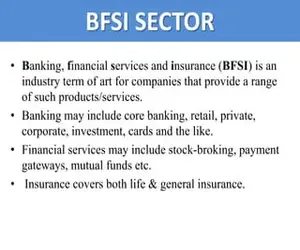What is BFSI – Banking, Financial Service and Insurance
Banking, financial services and insurance (BFSI) is set to grow rapidly in India due to increase in per capita income, introduction of new products, innovation in technology, expansion of distribution, networking and increasing awareness of customers about financial products . The BFSI industry continues to be a top priority focus industry for India’s economic development based on inclusive growth.
Table of Contents
What is BFSI?

Banking, financial services and insurance (BFSI) is the industry umbrella term for companies that offer a range of such financial products or services. This includes universal banks which provide a range of financial services or companies which operate in one or more of these financial sectors. BFSI includes commercial banks, insurance companies, non-banking financial companies, co-operative societies, pension funds, mutual funds and other small financial institutions.
The term is commonly used by information technology (IT), information technology-enabled services (ITES), business process outsourcing (BPO) companies, and technical/professional service firms that perform data processing, application testing, and software development activities in this domain. Let’s manage.
History of BFSI
The global BFSI industry faced severe turmoil in the early 21st century when a series of crises such as the subprime mortgage crisis in the US and the global recession that began in 2008 dealt a severe blow, resulting in negative growth. A 2013 report stated that the industry is coming back on track.
BFSI Sector – Banking Industry Overview

As we know that BFSI stands for banking, financial services, and insurance sectors. Fundamentally, it represents a major part of the multi-billion-dollar Indian economy, which includes all banking, insurance, and non-banking financial institutions. The latter are known as NBFCs. Furthermore, the BFSI industry encompasses a wide range of financial services firms such as brokerage and asset management.
Central Bank
This bank is the highest in the pecking order of any national economy with regulatory powers to oversee the functioning of the national (restricted to a country) banking industry. It authorizes the flow of money, increasing or decreasing it to keep inflation under control. Only the Central Bank of a country has the power to print a nation’s paper currency. In India, the Reserve Bank of India is the country’s designated central bank.
Scheduled Commercial Banks
All those banks which are included in the Second Schedule to the Reserve Bank of India Act, 1934 are scheduled banks.
Regional Rural Banks (RRBs)
RRB by definition, their incorporation is determined by the Government of India, essentially making them government banks. Their primary purpose is to serve the rural areas where they have been chartered to be established, however, this is not to be confused with a statutory restriction on expanding. Regional rural banks may or may not have branches in the urban district centres. Eg. Karnataka Vikas Anaj Bank.
Co-operative Banks
They aim to promote social welfare, hence the schemes are targeted towards the underprivileged or economically under-served sections of the society. Although they welcome business from all socio-economic classes.
Types of Banks : Different banks & their classifications (Global)

The banking industry caters to the needs of different sections of society; thus, the focus of banking becomes diversified, meeting the diverse needs of customers through different products, services, and methods. To accomplish this, we need distinctive types of banks that meet complex business and social needs. In this article, we will explain the different types of banking institutions, ranging from retail banks, commercial banks, co-operative banks, investment banks, and central banks to various types of specialized banks.
BFSI Industry – Domain Knowledge
Looking for knowledge and key business information about the BFSI industry?
The term “BFSI” is an acronym for Banking, Financial Services, and Insurance and is popular as an industry term for companies that provide a range of such products and services and are generally IT/ITES/BPO companies and technology companies. Used by professional service firms that manage data. Processing, application testing, and software development activities in this domain. Banking can include core banking, retail, private, corporate, investment, card, and the like. Financial services may include stock brokerage, payment gateways, mutual funds, etc. Insurance covers both life and non-life events.
BFSI Sector challenges and opportunities
- Capital adequacy is one of the top issues and challenges faced by Indian commercial banks as they continuously grow and comply with Basel III challenges.
- Regulatory Compliance: The entire BFSI sector needs to gear up for the evolving regulatory landscape. Banks should standardize regulatory reporting, requiring accurate reporting with minimal human intervention. To meet regulatory compliance, banks must have an advanced control environment. In addition, banks are required to comply with Basel III norms.
- NPAs and Accumulated Losses: With rising NPAs and accumulated losses from credit defaults, banks and NBFCs need to re-examine the credit administration process, including the quality of decisions, and conduct comprehensive financial due diligence.
- Leadership and the right talent are extremely important over the next 3–5 years as banks will need to work towards a growth agenda and fend off competition for talent from new local and foreign banks.
- Operation of Foreign Banks in India: The Reserve Bank of India is trying to bring foreign banks up to par with local banks so that foreign banks will be willing to convert into WOS. When major banks convert to WOS, they are likely to provide another level of competition to domestic banks, particularly in the deposit space.
- Banks acting as insurance brokers is a welcome move for the industry, which will gradually create a financial supermarket for customers.
Conclusion
The banking sector in India has responded positively and enthusiastically to the financial sector reforms. Entry of new private banks and the shaking up of public sector banks for competition. Financial sector reforms have brought India’s financial system closer to global standards. India is increasingly integrating with the global financial world, but the Indian banking sector still has a long way to go. To catch up with their counterparts.
FAQs
1. What is BFSI?
B.Sc. in Banking, Finance Services, and Insurance (BFSI) is an undergraduate-level course. The objective of the BFSI programme is to train the students in various aspects related to banking and its allied areas. The programme covers topics like banking, finance, insurance, investment, risk management, computer applications, IT, and more.
2. What is the significance of the BFSI sector?
BFSI courses help to develop the banking industry’s human resources. These courses give you an insight into the practical workings of the industry, prepare you for the risk factor, and enhance your knowledge of the rules and regulations that govern banks and financial institutions.
3. What will be the future of BFSI in India?
The BFSI sector now requires professionals who have advanced degrees and know how to work with disruptive technologies such as AI, ML, and blockchain. Upgrade, powered by O.P. Jindal Global University (JGU), has created an MBA programme in Digital Finance and Banking.
4. What are the recent developments in the banking sector?
Growth in retail credit demand, proliferation of ATMs and debit cards, reduction in NPAs due to securitization, improvement in macroeconomic conditions, diversification, interest rate spread, and regulatory and policy changes (such as amendments to the Banking Regulation Act) are key growth factors.
5. Why is the banking sector the fastest-growing sector?
Demand-Growth in the working population and rising disposable income will
increase the demand for banking and related services.
6. What are the factors that cause bank failure?
Banks can fail for a number of reasons, including low capitalization, liquidity, safety and soundness, and fraud.
7. How can banks improve productivity?
One way to increase bank operational efficiency is by training your employees to use cutting-edge technology to automate and streamline processes. Some other ways to improve employee productivity include offering flexible working arrangements and remote working.
8. What is covered under BFSI?
Commercial banks, insurance companies, non-banking financial companies, co-operative societies, pension funds, mutual funds, and other small financial institutions are all part of BFSI. The banking component of BFSI can include core banking, retail banking, private banking, corporate banking, investment banking, and cards.

